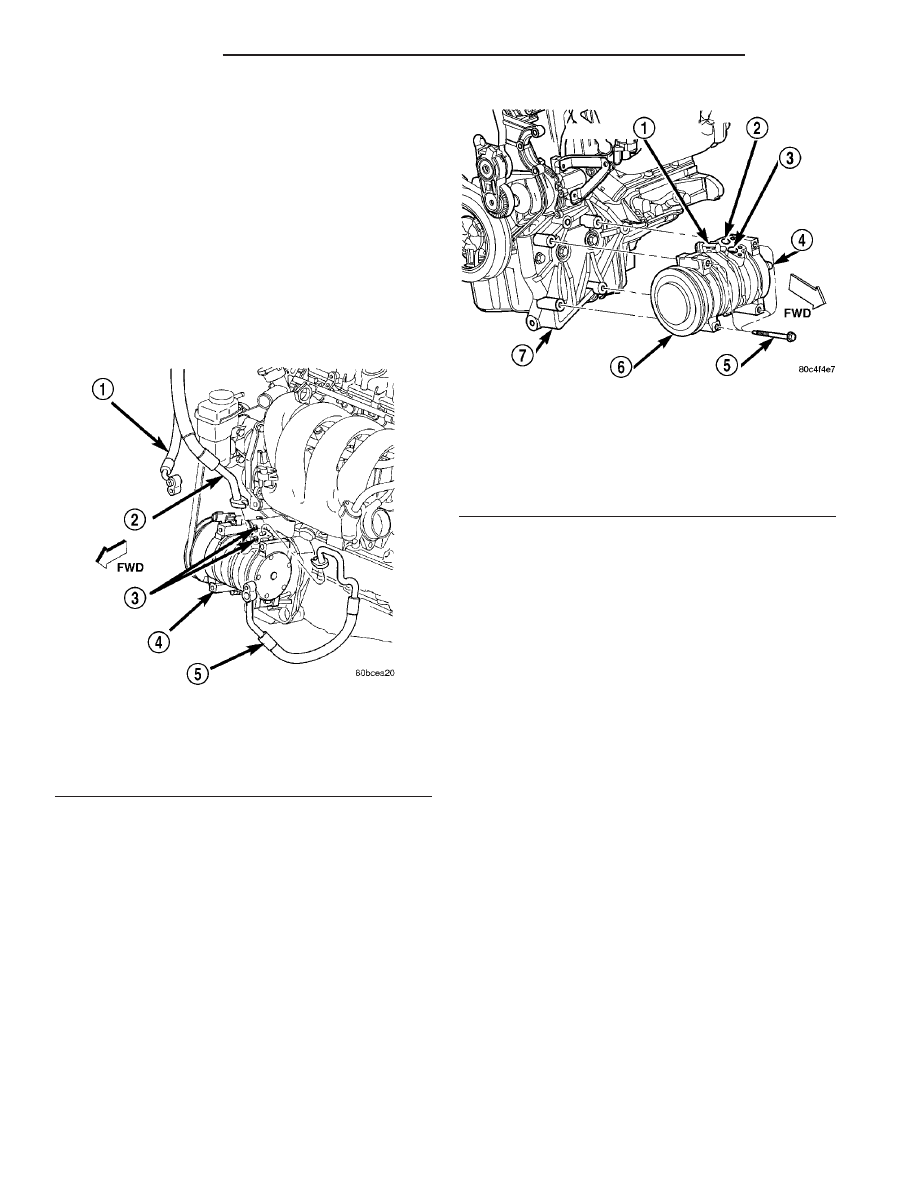Dodge Neon / Neon SRT-4. Manual - part 434

(3) Remove the accessory drive belt (Refer to 7 -
COOLING/ACCESSORY
DRIVE/DRIVE
BELTS
-
REMOVAL).
(4) Raise and support the vehicle.
(5) Disconnect the engine wire harness connectors
from the compressor clutch coil and the A/C high
pressure switch.
(6) Remove the bolts that secures the suction line
and discharge line to the A/C compressor (Fig. 5).
(7) Disconnect the suction line and discharge line
from the A/C compressor and remove and discard the
O-ring seals.
(8) Install plugs in, or tape over the opened A/C
compressor ports and the refrigerant line fittings.
(9) Support the A/C compressor and remove the
A/C compressor mounting bolts (Fig. 6).
(10) Remove the A/C compressor from the engine
compartment.
INSTALLATION
NOTE: If a replacement A/C compressor is being
installed, be certain to check the refrigerant oil level
(refer to Refrigerant Oil Level in this group). Use
only refrigerant oil of the type recommended for the
A/C compressor in the vehicle.
(1) Position the A/C compressor into the engine
compartment.
(2) Install the four bolts that secure the A/C com-
pressor to the mounting bracket. Tighten the bolts to
28 N·m (21 ft. lbs.).
(3) Remove the tape or plugs from the A/C com-
pressor ports and the refrigerant line fittings.
(4) Lubricate new rubber O-ring seals with clean
refrigerant oil and install them on the refrigerant
line fittings. Use only the specified O-ring seals as
they are made of a special material for the R-134a
system. Use only refrigerant oil of the type recom-
mended for the A/C compressor in the vehicle.
(5) Install the suction line and the discharge line
to the A/C compressor.
(6) Install the bolts that secure the suction line
and the discharge line to the A/C compressor. Tighten
the bolts to 12 N·m (108 in. lbs.).
(7) Connect the engine wire harness connectors to
the compressor clutch coil connector and the A/C high
pressure switch.
(8) Lower the vehicle.
(9) Install the accessory drive belt (Refer to 7 -
COOLING/ACCESSORY
DRIVE/DRIVE
BELTS
-
INSTALLATION).
(10) Reconnect the negative battery cable.
(11) Evacuate the refrigerant system (Refer to 24 -
HEATING & AIR CONDITIONING - STANDARD
PROCEDURE - REFRIGERANT SYSTEM EVACU-
ATE).
(12) Charge the refrigerant system (Refer to 24 -
HEATING & AIR CONDITIONING - STANDARD
PROCEDURE
-
REFRIGERANT
SYSTEM
CHARGE).
Fig. 5 A/C Compressor Lines
1 - LIQUID LINE
2 - SUCTION LINE
3 - BOLTS (2)
4 - A/C COMPRESSOR
5 - DISCHARGE LINE
Fig. 6 A/C Compressor - Typical
1 - CLUTCH COIL WIRE CONNECTOR
2 - DISCHARGE PORT
3 - SUCTION PORT
4 - HIGH PRESSURE CUT-OUT SWITCH
5 - BOLT (4)
6 - A/C COMPRESSOR
7 - BRACKET
24 - 44
PLUMBING
PL/SRT-4
A/C COMPRESSOR (Continued)